In this article, I discuss the why, when, and how of solar panels fusing. You’ll find out when it’s necessary to fuse your solar panels, how to figure out the fuse amperage ratings, and how to actually fuse the solar panels.
Let’s get started!
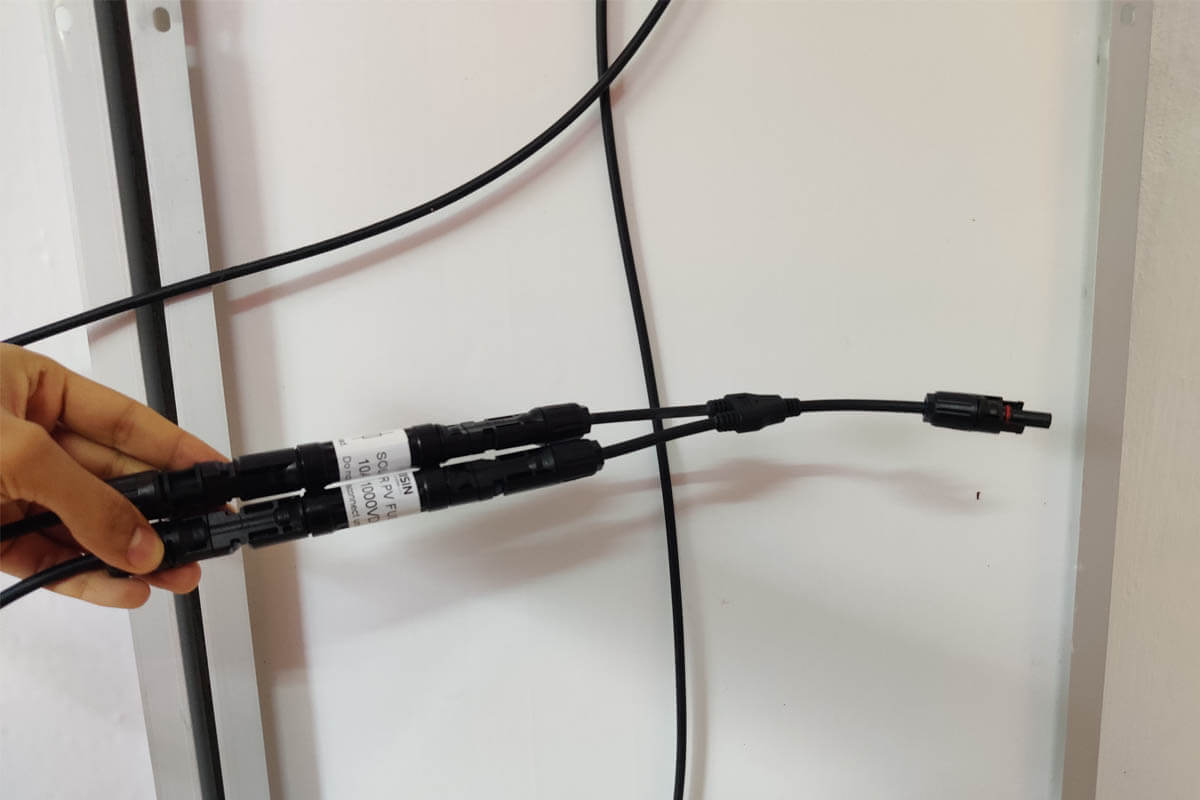
Do you need a fuse between the solar panel and the charge controller?
While it is generally recommended as a means of over-current protection, you are not always required to use a fuse between your solar panels and the solar charge controller.
Here’s a simple rule to follow:
If your solar panels are connected in series, a fuse is usually not required.
This is because a series connection doesn’t increase the system current (amps), and it won’t push more current through the panels than they can handle.
On the other hand, if you have parallel connections in your solar system, it’s highly recommended, and often necessary, to fuse each solar panel or string of panels in the array.
In a parallel setup, the current of the entire array is equal to the sum of the currents from all the solar panels or strings of panels.
In the event of a short circuit in one of the panels, its internal resistance becomes negligible. Since electrical current follows the path of least resistance, all the current from the other panels or strings will flow through the shorted panel. If that panel isn’t designed to handle such a high current, it could suffer damage or even pose a fire hazard.
For more information on the difference between series and parallel solar panel connections, please refer to this page.
When do you need to fuse your solar panels?
According to the National Electrical Code (NEC) Article 690.9, you should use fuses if the Maximum Current of your solar array exceeds the Maximum Series Fuse Rating of the solar panels.
The Maximum Series Fuse Rating can typically be found on the solar panel’s nameplate. But what exactly is the Maximum Current of the solar array?
To understand this, consider that in a parallel configuration, the total current of the solar array is the sum of the currents from all the solar panels or strings in the array.
The highest amount of current a solar panel can produce is its short-circuit current (Isc). So, the highest expected current from the solar array is the sum of the short-circuit currents of all the panels or strings.
For example, if you have 4 solar panels wired in parallel, each with an Isc rating of 5 Amps, the total short-circuit current rating of the array is 20 Amps (4 times 5 Amps).
However, remember that this rating is determined under standard testing conditions, which involve a specific level of simulated sunlight.
In situations of higher sunlight intensity (over-irradiance), the actual short-circuit current may exceed this rated value. NEC 690.8 takes this into account by defining the Maximum Current as the sum of the short-circuit current ratings of the PV modules multiplied by 1.25.
To make this clearer, let’s take an example:
I have 2 – 100W solar panels which each has the following specifications:
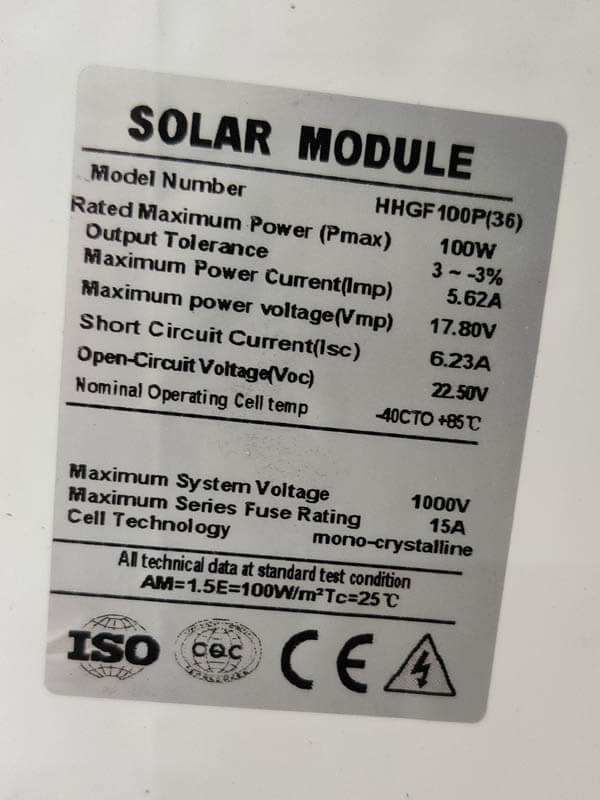
On the nameplate, the manufacturer provides the following specifications for each solar panel:
- A Short Circuit Current (Isc) rating of 6.23 Amps.
- A Maximum Series Fuse Rating of 15 Amps.
Now, let’s determine whether I would need to fuse these two solar panels when connected in parallel.
First, I’ll calculate the total Short Circuit current of the array:
Short Circuit Current of the array (Amps) = Short Circuit Current of one solar panel (Amps) x 2
Short Circuit Current of the array (Amps) = 6.23 Amps x 2
Short Circuit Current of the array (Amps) = 12.46 Amps
Next, I’ll calculate the Maximum Current of the array using NEC’s 1.25 rule:
Maximum Current of the array (Amps) = Short Circuit Current of the array (Amps) x 1.25
Maximum Current of the array (Amps) = 12.46 Amps x 1.25
Maximum Current of the array (Amps) = 15.57 Amps
In this example, since the Maximum Current of the array exceeds the Maximum Series Fuse Rating of the individual solar panels (15.57 Amps > 15 Amps), I would need to use fuses for these solar panels.
Now, let’s calculate the proper size for the fuses I’ll need.
How to size the fuses between your solar panels and the charge controller?
According to NEC’s Table 240.6 (A), the standard fuse sizes are:
10, 15, 20, 25, 30, 35, 40, 45, 50, 60, 70, 80, 90, 100, 110, 125, 150, 175, 200, 225, 250, 300, 350, 400, 450, 500, 600, 700, 800, 1000, 1200, 1600, 2000, 2500, 3000, 4000 5000, and 6000 Amps.
To determine the size of the fuse that you need for your solar panels, multiply the Short Circuit Current rating (in Amps) on your solar panels by 1.56 and match that value to the equal, or next larger standard fuse amp rating.
However, make sure not to exceed the Maximum Series Fuse Rating on your solar panels.
Following up on our previous example, each solar panel has a Short Circuit Current rating of 6.23 Amps. The first step would be to multiply that value by 1.56:
Fuse Size (Amps) equal to or greater than 6.23 Amps x 1.56
Fuse Size (Amps) equal to or greater than 9.71 Amps
The next larger standard fuse amp rating is 10 Amps.
Since this fuse size does not exceed the Maximum Series Fuse Rating on my solar panels (15 Amps), I’ll use 2 fuses rated at 10 Amps, one for each solar panel.
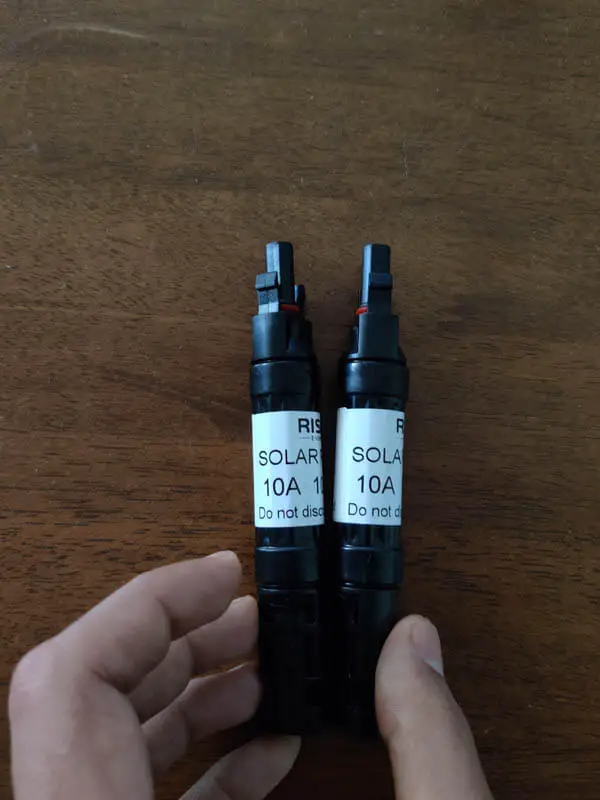
Solar panel fuse diagram: where to fuse your solar panels?
When fuses are required, a fuse must be placed on the positive lead of each solar string on the array. For example, if you have 4 solar panels in parallel, a fuse would be placed on the positive wire of each solar panel, totaling 4 fuses.
If you have 4 solar panels wired in a 2S2P configuration (2 parallel strings of 2 solar panels in series), a fuse should be placed on the positive wire of each string, totaling 2 fuses.
Let’s visualize this using diagrams.
Diagram 1: 4 solar panels in parallel
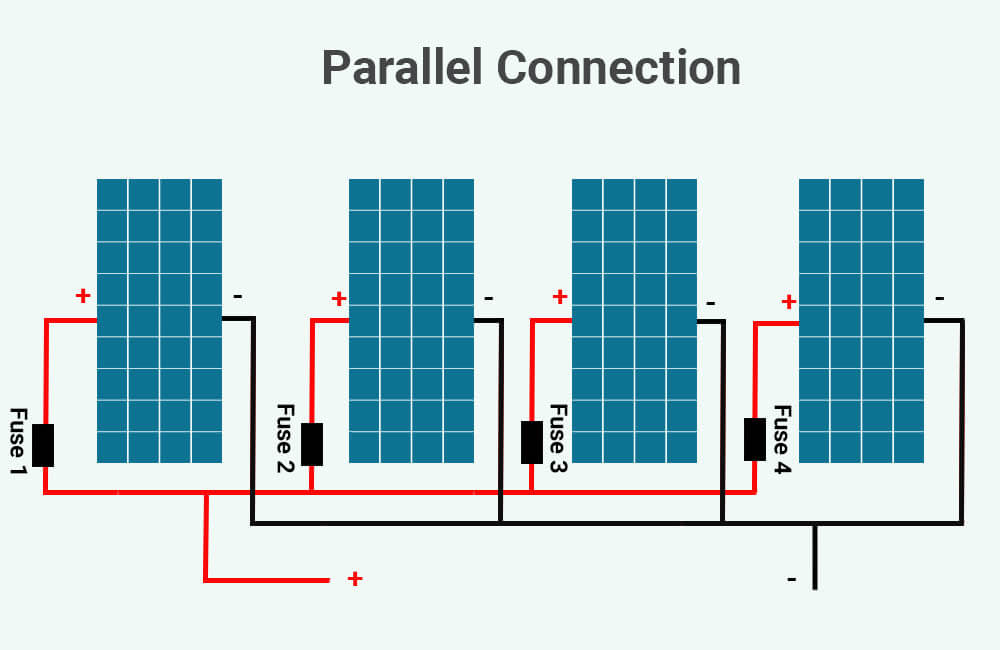
In this setup, you’d need 4 fuses, one for each solar panel connection. For example, if we use MC4 fuse holders, a fuse holder would be connected between the positive MC4 connector of each solar panel and an input of the MC4 branch connector.
Example 3: Parallel-Series connection
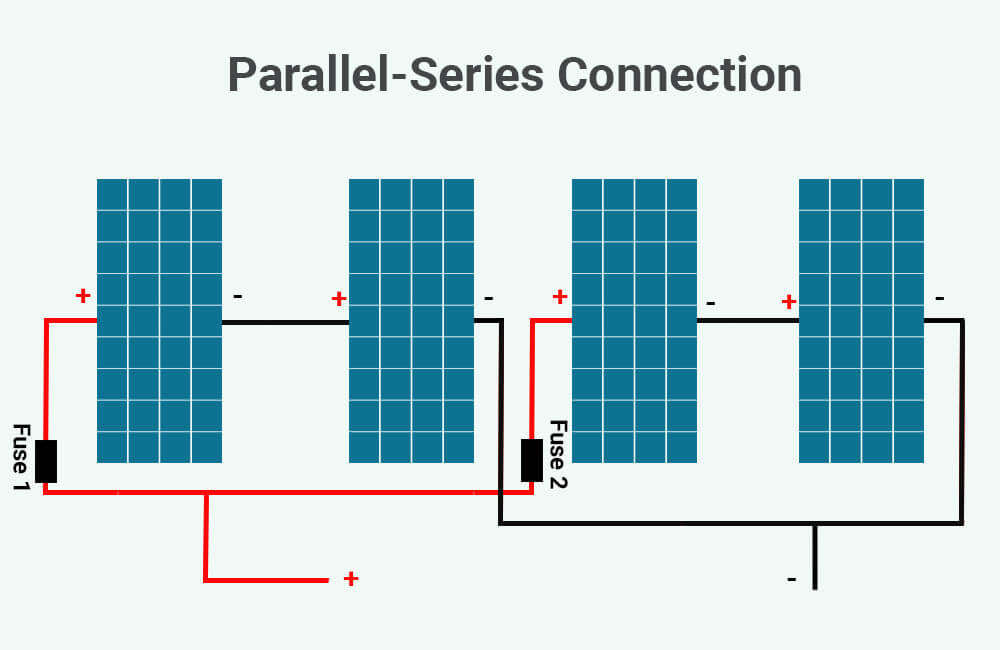
In this configuration, you’d need 2 fuses, one for each parallel string. If you’re using MC4 fuse holders, each fuse holder would be connected between the MC4 connector representing the positive end of each string and an input of the MC4 branch connector.
Now, let’s take a look at a real-life example to make this even clearer.
How to fuse your solar panels?
The simplest way to fuse your solar panels is by using MC4 fuses, which are essentially MC4 connectors equipped with fuse holders. These connectors link the solar panel’s connector to the branch connector.
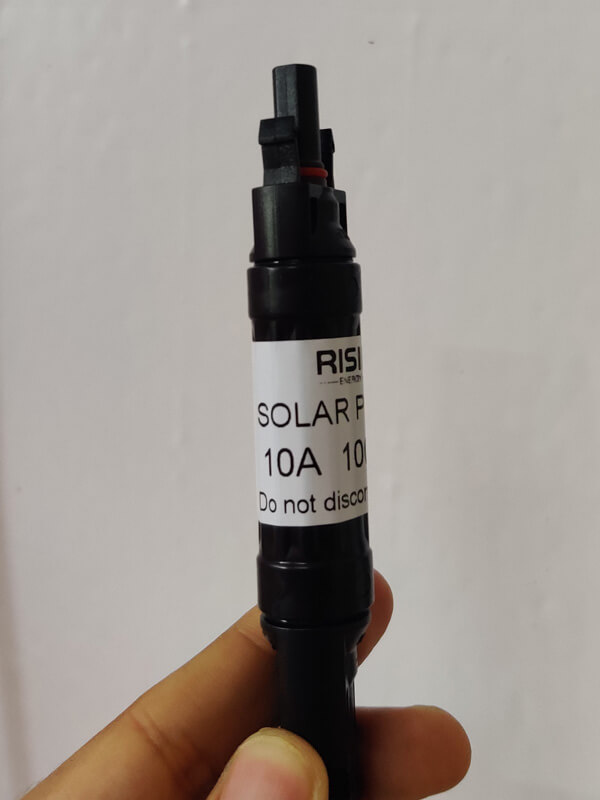
Once you have your fuses, identify the positive MC4 connectors on your solar panels; these are typically the male connectors and are often marked with a “+” sign.
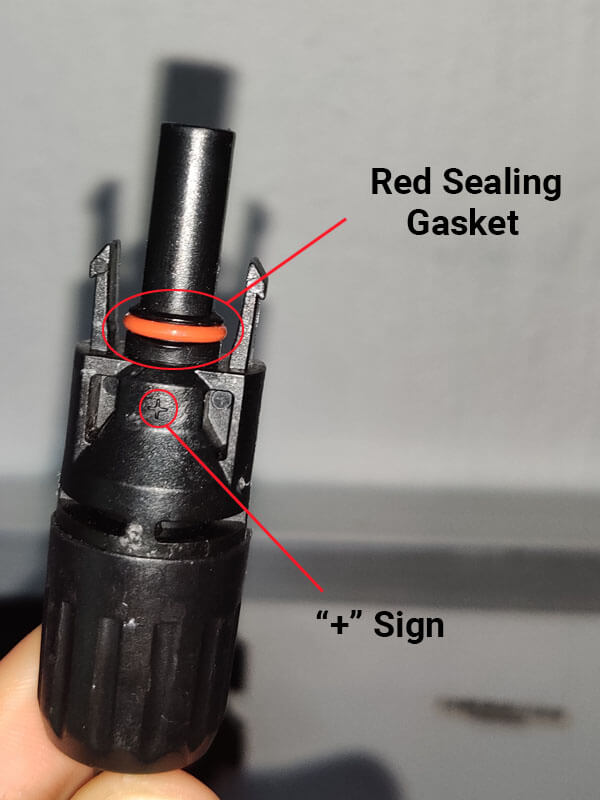
Once you’ve located the positive leads, attach them to your MC4 fuse holders.
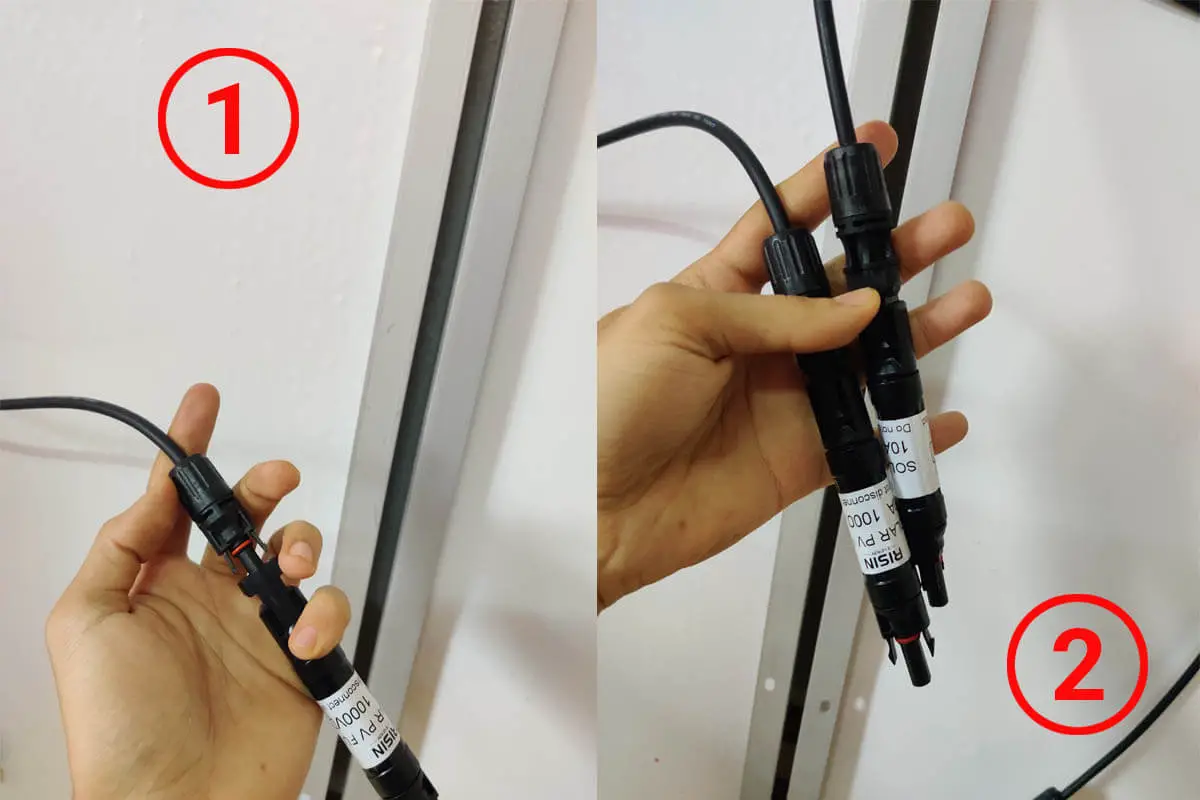
With the fuses now connected to your solar panels, you can link the MC4 fuses to the inputs of the first MC4 branch connector to create the positive wire for your solar array. Connect the negative MC4 connectors of your solar panels to the second MC4 branch connector to create the negative wire for the solar array.
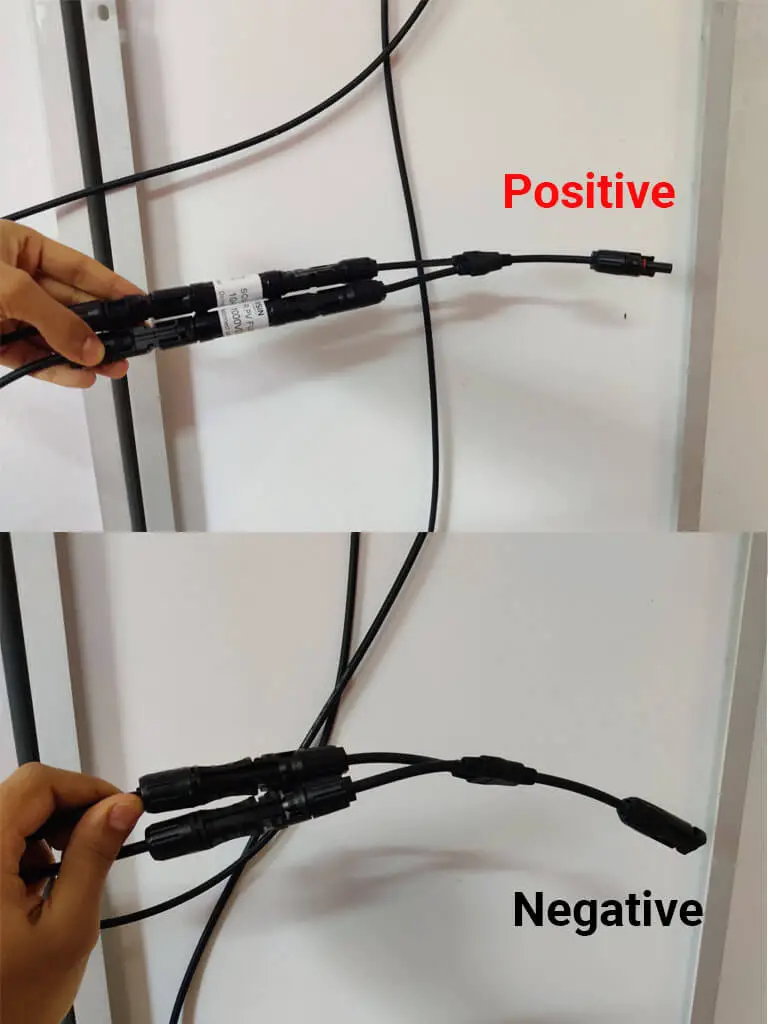
And there you have it! Your solar panels are now fused and ready to generate power.


Finally, the information I need given clearly and concisely. Thanks.
I agree 100% with Val! Thank you.
Thank you so much for all the free information. I’ve used a bunch of your instructionals to calculate my needs in getting my solar system going. I’ve learned a lot from you and it’s very, very much appreciated.
I thought the sizing factor was 1.56. why are you only using 1.25 factor to size the fuse?
Hello JC,
It’s 1.25 times the “Maximum Current”, which is equal to 1.25 time the Short-circuit Current (Isc). So the fuse size is actually 1.25 x 1.25 x Isc, which is 1.56 x Isc.
I hope this helps.